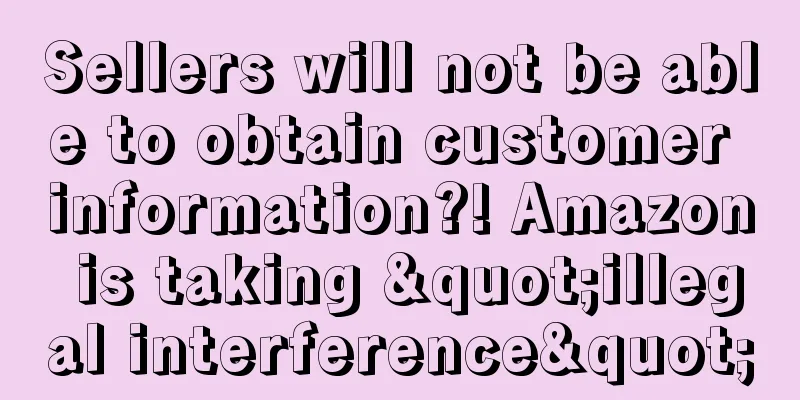Competitors are killing them all! Using loopholes to add sensitive words! Seller links are in danger!

|
The outbreak of the COVID-19 pandemic has forced people to stay at home in isolation. This change in lifestyle has forced people to switch from traditional offline shopping to online shopping. The cross-border e-commerce industry has been fully developed, and more people have noticed the "gold mine" of cross-border e-commerce.
As the leader among them, Amazon naturally attracted a lot of attention and set off a nationwide Amazon craze. Whether in Shaxian Snacks or Haidilao, you can hear passers-by discussing Amazon.
However, perhaps for this reason, the number of third-party sellers on Amazon is gradually reaching saturation. Naturally, competition on Amazon is becoming more and more fierce. While sellers are trying their best to increase sales, some sellers choose to cross the platform's red line and use unfair means to attack their peers to reduce competitive pressure . Recently, a seller told the forum about his experience of being framed by his peers.
It is understood that during the six months of sales, the seller's product gradually entered the top 15 in the category through in-site advertising and flash sales. Seeing good sales, the seller decided to hold another 7-day flash sale to stimulate sales and impact the category ranking. This time, the flash sale was effective, and the product lived up to the seller's expectations and reached the fifth place in the category.
But the sellers were not excited for long before bad news came. The product was inexplicably labeled as an adult product, which made the advertising function unusable and the original ranking lost . The helpless sellers had to submit a complaint letter to Amazon. Fortunately, the product returned to normal and the advertising function was restored.
"As long as the mountains remain, there will be no shortage of firewood." The seller continued to operate with this mentality. Just when the sales of the product gradually picked up, the seller received a performance notification and his product link was removed because the product contained poppy and lion's ear grass, which are prohibited products from sale on Amazon .
▲ The picture comes from Zhiwubuyan
The seller was very confused. Although he knew that his product did not contain these ingredients, he still submitted a complaint letter to Amazon in order to save the link. However, just two days after the link was appealed, the seller received another notice from Amazon, this time it was detected to contain potential banned substances , so Amazon removed the product again.
The seller who wanted to find out the specific reason asked customer service and learned that it was because the product was judged as a nitrous oxide splitting device . Although there was no performance notification and complaint entry for the relevant team this time, the seller who did not give up opened multiple cases and asked customer service to help review whether his listing contained sensitive words or illegal pictures.
Customer service informed the seller that no sensitive words or illegal images were detected in the listing, and the trigger was that the system captured illegal words. What exactly is going on?
The seller’s listing was not detected as containing sensitive words, but the system captured them. This is indeed very confusing. To understand the reason, we must first understand the working mechanism of Amazon’s detection system.
When Amazon's detection system detects that a listing contains sensitive words, it will remove the listing. This removal is not only for a single site, but for all Amazon sites around the world . By taking advantage of this loophole, those with bad intentions can upload other people's listings across sites and add sensitive words to them to frame sellers, causing the competitor's seller account to be suspended, thereby achieving the purpose of restricting competitors.
Because all listings belong to Amazon, sellers only have the right to edit the listings. At the same time, listings can essentially have multiple managers, so even if the seller turns off global synchronization, it cannot prevent others from making cross-site spoofs. If the seller is unfortunately caught, how should he save himself? The editor has sorted out the following methods.
1. Ask customer service or use UPC code to query
Once a link is removed, the seller can open a case to ask customer service to determine on which site the other party modified the product information and what information was modified.
Because cross-site follow-selling utilizes the UPC code for follow-selling , sellers can add new products to their inventory, enter the UPC code to query the product, and then see whether other sites have uploaded products using the same UPC code.
2. Ask customer service for help
Sellers can seek help from customer service and ask them to help them obtain editing rights for the listing.
First, the seller needs to find the brand barcode and upc code , and use the barcode generator to generate a barcode from the 13-digit upc code.
▲ Barcode
Then find a thermal printer, print out your brand barcode and the upc barcode you just generated, the same size as the shipping label, then stick them all on your product and take a real photo .
▲ Brand barcode
3. Modify data using templates
The other party makes malicious changes, usually using templates to modify the seller's product information, but it is not necessary to use templates with very detailed categories, because some templates with very detailed categories lack some data. It is recommended to use templates under the first-level or second-level categories, which basically contain the modified information.
4. Take preventive measures
Sellers can authorize the brand registration of their products to other sites. Regardless of whether the seller does it or not, the editing rights of the listing must be firmly in their own hands . Amazon is not a lawless place. As Amazon's efforts to combat unfair competition become more and more intense, all those who trample on the rules and exploit loopholes will be punished. I hope Amazon can fix the loopholes as soon as possible, not letting these ill-intentioned people take advantage of them, and build a good business environment of fair competition.
Do you have any thoughts or experiences you’d like to share about peer pranks and Amazon loopholes? Feel free to leave a comment below to share with us~ |
<<: The road to starting a business that sells billions of products
>>: Big news! Prime Day may be held in June? Amazon advertising bug reappears
Recommend
What is Packeta? Packeta Review
Packeta was founded on July 24, 2008. It is an int...
Revealed! The first batch of sellers settled in SHEIN are quietly making a fortune
On May 6, SHEIN officially announced the launch of...
Great sales turned losses into profits in the first half of the year! Another clothing giant enters cross-border e-commerce
It is learned that just last week, East China'...
What is KiwiCo? KiwiCo Review
Founded in 2011, KiwiCo is an e -commerce platform...
What is Trade B2B? Trade B2B Review
TradeB2B.net is a world-renowned B2B website direc...
Shopify teams up with streaming platform Roku to launch shoppable TV ads!
It is learned that according to foreign media repo...
How to appeal if a customer complains that a product on Amazon is not genuine
Because most sellers generally do not require sup...
What is the RoHS Directive? RoHS Directive Review
The RoHS Directive is the "EU Directive on th...
Attention! Due to Amazon's new pricing requirements, some ASINS may not be able to provide coupons!
Promotional offers and listing optimization are th...
How to correctly issue the invoice required by Amazon?
In Europe, VAT invoices are important documents f...
Operation Tips-Solutions for Amazon Store Closure
First of all, let me ask everyone, if your accoun...
Global review merger! Just now, Amazon officially announced...
In the past, Amazon has always strictly guarded i...
Entire categories disappear on Amazon? Something big happened right after Primeday
Membership Day on the US site officially ended thi...
Walmart and Home Depot warn that the US retail industry will face a difficult year
It is learned that on February 21, Walmart and Hom...
Amazon's new free feature, come and use it!
In the past two days, Amazon released 5 new featu...









